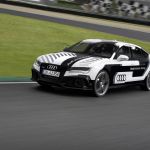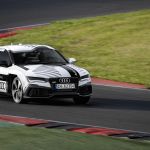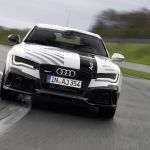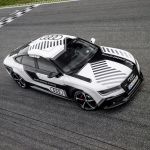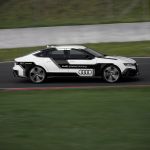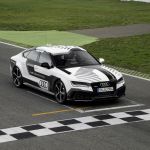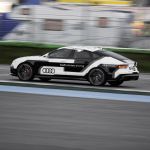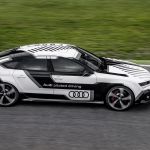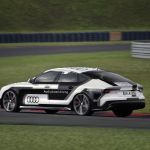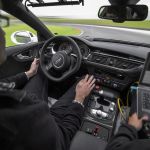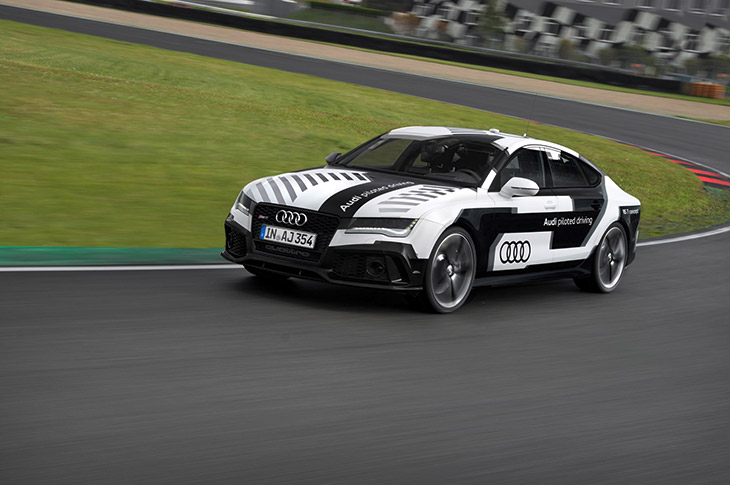 Audi has developed the world’s sportiest piloted driving car. Following the spectacular drive by the Audi RS 7 piloted driving concept at the German Touring Car Masters (DTM) season finale in Hockenheim, the innovative technology platform is now making an appearance on the challenging circuit of the Ascari Race Resort – at racing speed, without a driver.
Audi has developed the world’s sportiest piloted driving car. Following the spectacular drive by the Audi RS 7 piloted driving concept at the German Touring Car Masters (DTM) season finale in Hockenheim, the innovative technology platform is now making an appearance on the challenging circuit of the Ascari Race Resort – at racing speed, without a driver.
“We are pressing forward with one of the most important trends in the automotive world with our technical solutions for piloted driving,” says Prof. Dr. Ulrich Hackenberg, Board Member for Technical Development at AUDI AG. “We presented the sheer fascination of this development at the DTM race in Hockenheim. Now we are demonstrating just what this technology platform is capable of on a circuit that is famous for an even more challenging profile with a wide variety of bends and chicanes. This will clearly reinforce the technical achievements of the Audi engineers once more.”
Audi has long been a driving force in the area of highly automated driving. The brand’s development efforts have produced a number of spectacular feats. In 2010, for instance, a driverless Audi TTS conquered the legendary Pikes Peak mountain race circuit in Colorado, USA. Audi has time and again showcased the potential of the technology with demonstrations at the limit. With 560 hp and a top speed of 305 km/h (189.5 mph), the Audi RS 7 piloted driving concept car exemplifies Vorsprung durch Technik.
The Audi RS 7 piloted driving concept car on the race track
The Audi RS 7 piloted driving concept car is a technology platform with which Audi is exploring the possibilities of piloted driving at its most dynamic. The large, five-door coupe is largely identical to the production model, but its electro-mechanical power steering, the brakes, the throttle valve and the eight-speed tiptronic that distributes the power to the mechanical quattro drive system are controlled automatically.
There are two primary technological considerations during piloted driving at the physical limit: the highly precise orientation of the vehicle on the road and absolute control of the vehicle at the handling limits.
The technology platform uses specially corrected GPS signals for orientation on the track. Accurate down to a centimeter, these differential GPS data are transmitted to the vehicle via WLAN according to the automotive standard and redundantly via high-frequency radio. Parallel to this, 3D camera images are compared in real time against graphical information stored on board. The system searches in each of the countless individual images for several hundred known features, such as building patterns behind the track, which it then uses as additional positioning information.
Control of the vehicle at the handling limits is another outstanding feature of the Audi RS 7 piloted driving concept car. Comprehensive on-board networking coupled with the highly precise control of all actors relevant to driving enable the technology platform to drive at the physical limits. The Audi engineers intensively investigated piloted driving at the handling limits, putting the technology platform through several thousand test kilometers on a variety of routes.
To demonstrate its capabilities on the race circuit, the Audi RS 7 piloted driving concept car drives a clean ideal line – with full throttle on the straights, precisely metered deceleration at the ideal braking point before the corners, precise turn-in and perfectly metered acceleration when exiting the corners. Forces of over 1.3 g occur during braking, and lateral acceleration in the corners can reach 1.1 g.
On the track in Hockenheim, the RS 7 piloted driving concept reached a maximum 240 km/h (149.1 mph). Its top speed is 205 km/h (127.4 mph) in Ascari. With its challenging ascents and descents, tight chicanes and banked bends, the Ascari circuit poses an even greater challenge for the technology of the Audi RS 7 piloted driving concept. As well as high longitudinal and lateral acceleration, this track subjects the car to dynamic axle load changes.
The race track is also the most demanding test bed for production when it comes to piloted driving. The future systems must also work extremely precisely and with zero errors in critical situations. They therefore must be capable of properly assessing the current situation even at the physical limit. This test bed provides the Audi engineers with a variety of insights for production development, such as for the development of automatic avoidance functions in critical driving situations.
2014 Audi RS 7 Piloted Driving Concept
Source: Audi
